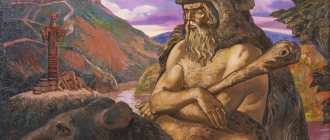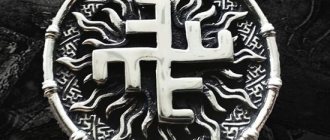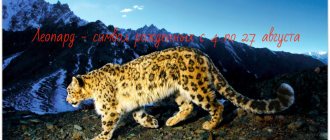Our ancestors believed that there were three main worlds, intended for people, gods or otherworldly forces. Not every deity had the privilege of traveling freely through these worlds, but Veles (Volos) was considered one of these lucky ones.
This god is a very controversial person. Despite his patronage of people, in some legends he appears as an opponent of the supreme ruler Perun. The ancient Slavs said that Veles helps those in the know, namely those who were familiar with magic and possessed life wisdom. What knowledge about this mysterious god has survived to this day? How can you enlist the support of Veles?
Veles could travel in three worlds
Place in the pantheon of Slavic gods
The exact origin of Veles is not known. At the moment there are 2 legends, according to one of which he came from the cow Zemun, according to the other he was created by Rod from primary matter. One thing remains for sure - the enormous power and wisdom of God.
Veles is one of the first-born gods, responsible for the law of correct movement, which makes him the patron of everything seasonal: agriculture, livestock. It was the Slavic god Volos who set the movement of the world, which was previously motionless.
He occupies an important place in the pantheon of Slavic gods, however, given the fact that he is a lunar god and is strongly associated with dark forces, the idol was installed in the lowlands. In the center of the temple, a stone idol can be found only where the idol of Perun was missing. However, the laws of Veles were held in high esteem.
Veles' Law
Veles refers to the wise deity who protects and knows the secrets of the universe. They appeased him with the help of bloodless sacrifices. Gifts were given of nuts, berries, medicinal plants, kvass, honey, and copper coins.
The main law of Veles is harmonious coexistence with the outside world.
The peoples who worshiped him respected nature and creativity. The attributes of God express his unity and harmony with nature.
Veles - father and judge of truth
There is every reason to believe that it is Veles who monitors the implementation of laws and contracts, he is the father and judge of truth, like Hermes and Odin. Therefore, “The second (idol) Volos, the god of Scott, was held in great honor by them (the pagans)” (“Gustin Chronicle”).
The mention of Veles in the treaty, next to Perun, the patron saint of the prince and his squad, is not accidental. The Germans also called upon Mercury in tandem with the warlike Mars. And it is no coincidence that there is a sacred couple here - a wise, old, not entirely positive in the Christian sense of the word “bestial god” and a strong, young warrior-ruler. Despite the obvious attributes of blackness, Veles, like Odin, Mercury and Hermes, is the god of science and wisdom. In the “Tale of Igor’s Campaign” we find “How could we sing, prophetic Boyane, Velesov’s grandson...”. His name is also found in the later recorded ritual text of the Macedonian Bulgarian-Pomaks, the so-called “Veda of the Slavs” in the ed. Verkovich (see for example IV, 5. 5-13).
Attributes of the god Veles
The patron god of magicians and sorcerers could appear in the form of a huge bear, a fiery serpent, a wolf or a tour (bull).
Its symbol is the cornucopia.
Wood : ash, oak or yew. These breeds are used to make talismans.
When depicting, horns, beard and long hair (braids), and a staff are necessarily used. Despite his enormous strength, Veles was the god of peaceful life, calling for taking up a sword only to protect his family and homeland.
In love
People of this zodiac sign magically feel when love comes into their lives. They can go through options for a long time, often change partners with a cold heart, leaving them or being rejected. They are not amorous, they rarely build castles in the air, they can dream of an ideal family and great love, but at the same time see flaws in all representatives of the opposite sex that prevent them from making a choice.
They can be quite lonely, look for a mate for a long time and find the best, in their opinion, option closer to the second half of life. But often in adulthood their marriage breaks up due to demandingness and excessive desire for correctness and justice.
Veles is a wise patron
Veles is not a warrior, despite the enormous strength given to him by nature, he was the patron of the world. Ancient Patron God:
- He also helped shepherds and hunters with livestock and wild animals.
- Travelers.
- Guardian of Navi and the souls of deceased ancestors, he also protected wisdom and knowledge, helped the souls of the dead move to the afterlife according to their merits during life, and was a judge of the dead.
- Tester of people's faith and strength.
- A wizard of enormous power, the patron of all things unknown and supernatural.
- Patron of trade and law.
- Giver of earthly riches and good luck. In addition to the main image of the cattle god, he is described in legends as the god of luck.
- Patron of priests, boyans (storytellers), shamans and all people striving for knowledge.
The power of Veles is directly related to natural cycles. Everything has a beginning and an end, just like life. The god of magic Veles can trigger various cycles and create powerful illusions.
Veles the cattle god is the patron of livestock and wealth.
Veles, Volos, Vlas, Vlas - “cattle god” in Slavic mythology - (son of Rod, brother of Khors) patron of livestock and wealth , the embodiment of gold, trustee of merchants, cattle breeders, hunters and cultivators. The name Veles, according to many researchers, comes from the word “hairy” - shaggy, which clearly indicates the deity’s connection with cattle, whose patronage he was. (It is also possible that the word “magician” comes from the name of this god and from the custom of his priests to dress in “shaggy” fur coats turned outward to imitate their deity)
All lower spirits obeyed him. Veles married Azovushka (the spirit of the Azov Sea (daughter of Svarog and Mother of the Earth). Buyan Island became the magical abode of Veles and Azovushka.
Symbols of Veles
The Veles amulet has enormous power and has a great influence on its wearer. It is better not to use this symbol for a person of weak spirit.
- The main symbol is bull horns as a tribute to his origin from the divine cow Zemun and a symbol of power over cattle. His main designation as a bestial god has been preserved to this day.
- A bull depicted next to a god or a bull's skin.
- The bearskin (or bear) symbolizes power over the world of wild animals and the ability to transform into animals.
- The staff is a symbol of travel. The staff also denotes the power of God over 3 worlds: Rule, Reality and Navy.
- The image of black hair indicates his relationship to the dark gods (the patron of the world of the dead is Navi). And the image in the form of a gray-haired old man speaks of his wisdom.
- His image with a raven on his shoulder and the length of his robe indicates enormous magical power.
- The image of Veles in a wreath and with folk instruments in his hands indicates the masculine power of God and the ability to love recklessly.
The symbols of Veles are also the six-pointed star, the lizard sign and the eternal union (a symbol of the unification of the feminine and masculine principles). All symbols and signs are used in amulets and talismans of residents of different cultures.
Veles and his symbols
In addition to these functions, Veles provided assistance to travelers and fishermen, could bestow wealth on a person, and stood guard at the Kalinov Bridge, which connected the world of the dead and the living. Veles did not control the forces of life and death - he was above this, because his task was to maintain order, and therefore non-interference.
Veles was often contrasted with Perun, although he cannot be classified as a dark deity. In Rus' there were many sanctuaries dedicated to this god. Most often, temples were installed near water sources, in dense thickets or ravines. It was considered unacceptable to build sanctuaries of Perun and Veles nearby, because these gods were competitors, although they remained two sides of the universe.
The Veles amulet known to us was called “Bull’s Head”. This symbol consists of a curved line and a triangle that really resemble the head of a bull. Most often, such a protective talisman was worn by men. It was believed that the Veles amulet bestows wisdom, attractiveness, willpower and spiritual enrichment.
Veles - patron of animals
Veles is an extraordinary god who could travel through three worlds, controlling them, but without disturbing the legal flow of time. Slavic legends sometimes describe him as an opponent of Perun who fought for power. Veles became second, but this did not harm his power at all. The most mysterious, mystical and unknown side of life remained with him, and people today remember his name as the personification of a wise patron and guardian of nature.
Variants of the Veles amulet
Any amulet provides tremendous support to its owner. You should choose a suitable amulet taking into account your profession, character and willpower. Any thing can become a talisman: clothing, household items, professional tools. Let's consider each option separately.
Bear paw print
The bear paw amulet can be made of wood.
The bear's paw is considered a powerful amulet that helps in the fight against serious illnesses. Considering that the bear is one of the guise of Volos, which is a strong animal and a symbol of the union of the world of people and animals, as well as the afterlife and the human world, this amulet has great power.
The bear's paw is suitable for people of courageous and dangerous professions, as well as people seeking to learn the secrets of the worlds or master witchcraft.
By profession, a bear's paw can be purchased by traders (helps to receive revenue and not incur losses), warriors, judges and police officers (protects against death at work and various persecutions).
There is a belief that everyone who wears a bear's paw amulet falls under the protection of Veles. The talisman has strong protective energy against the evil eye, damage and unkind rumors.
Wolf paw print
Veles took on the guise of a wolf less often than a bear, however, meeting the footprint of a wolf (a paw with 4 toes) in the forest was a sign of good luck and quick wealth.
The wolf paw pendant is suitable for those who strive to achieve their goals, fearless people who protect their lands and family.
The seal of Veles (wolf and bear paw) can be worn in the form of silver jewelry, embroidery on clothing or on a bracelet. The main rule is faith in the power of the amulet and the presence of character traits of totem animals: strength, fearlessness and nobility.
In career
Representatives of this Slavic deity strive for high achievements in all spheres of life, including material ones. It is for this reason that they should plan a career almost from early youth and try all options. Depending on their abilities, such people can achieve a lot in life - they can be excellent athletes, gymnasts, artists, but it is best for them to choose activities that are associated with material wealth and a gradual ascent to wealth.
These people can make an excellent military career, become excellent scientists, doctors of science, lawyers, barristers, and succeed in government agencies and authorities. Activities that require soulfulness, artistry, and sociability are unlikely to bring them great success and guaranteed material income.
Slavic pagan horoscope
| Stribog (Kryshen) – January 21 – February 20 | Maya (Seva) – August 24 – September 8 |
| Rod – February 21 – March 20 | Women in labor - September 9-11 |
| Yarilo (Yar) – March 21 – April 20 | Makosh (Mokosh) – September 12-27 |
| Lada (Lelya) – April 21 – May 21 | Svarozhich – September 28 – October 15 |
| Letnitsa (Lelya) – May 22 – June 2 | Morana – October 16 – November 1 |
| Kostroma – June 3-12 | Semargl – November 2-22 |
| Dodola (Share) – June 13-21 | Winter – November 22-30 |
| Veles (Kolyada) – June 22-July 6, July 8-22 | Vyrgon – December 1-10 |
| Kupalo – July 7 | Kitovras (Karachun) – December 11-23 |
| Dazhdbog (Vyshen) – July 23 – August 23 | Perun (Indrik) – December 24 – January 20 |
Sign of Veles
The sign of Veles is depicted in the form of a bull's head, reminiscent of an inverted letter A. Suitable for men and boys (women to achieve success in society). Represents wisdom, flexibility of mind, sorcery. Wearing the sign enhances the sixth sense (intuition) and makes it easier to find a way out of difficult life situations.
Wheel or circle
The Slavic god who started the movement of the world, the Wheel of Veles symbolizes the cyclical nature of life.
Kolovrat is one of the varieties of Veles’s amulet that gives strength on the path of knowledge and solving complex life problems.
Wearing the wheel of life helps the owner in implementing plans and in business. Attracts good luck and wealth.
Star
According to the legends of the ancient Slavs, the star of Veles indicates the unity of the two worlds of Reveal and Navi, which at the same time means the unification of the forces of light and darkness, female and male, good and evil.
Wearing the “Star of Veles” amulet promotes a harmonious state of mind; it is suitable for those who are looking for their own path in life or are engaged in spiritual self-development.
Rune
According to mythology, runes were created by the god Veles. The sign of God himself is the wind rune. The wind rune helps in self-development, acquiring new knowledge, helps to gain humility and wisdom.
It is important to remember that the signs of Veles are a connection with the world of the dead; incorrect use of its talismans can lead to dire consequences. People who are weak in spirit and physically should not be chosen.
Velesovik
The male symbol - Velesovik (svyatadar) protects on a long journey, helps hunters and fishermen avoid the catastrophic effects of raging nature (thunderstorms, strong winds).
The Velesovik amulet is also suitable for researchers and people whose lives involve being in harsh climatic conditions.
Who is this in Slavic mythology?
The sphere of Veles's patronage is very extensive - he is considered the ruler of the three worlds, of which, according to Slavic beliefs, all things consist. Veles moves freely between Navy (the underground kingdom of the dead), Reality (the world of the living) and Prav (the abode of the gods), and is considered a mystical guide of souls between worlds. Veles was also that happens in the world.
Important! According to legend, Veles is the son of the primordial god Rod, a deity endowed with neither clearly positive nor negative traits.
It symbolizes the unity of good and evil in the Universe, their cyclical nature and eternal movement. Veles was depicted as a tall and very thin old man in black and white clothes, in his hands he holds a staff - a symbol of knowledge and magic. This god appeared to people in the form of a bear or bull.
We invite you to see what the god Veles might look like:
Briefly noting the most important thing about this mysterious and powerful deity, one cannot help but recall that Veles is subordinate to all the patron spirits living side by side with man - these are:
- kikimores;
- brownies;
- barnyards;
- goblin;
- aquatic.
The list can be very long. A special place in it is occupied by werewolves, who accompany Veles, wandering around the world in the guise of a huge bear.
Reference! The sacred animals favored by Veles are the cat and the eagle owl. The Slavs treated ordinary domestic cats with great respect because it was believed that the mysterious god would severely punish anyone who offended his beloved animal.
How and from what to make an amulet
The material for the Veles amulet can be wood, silver, gold, animal bone, leather. Cheap alloys are not suitable for creating a talisman, nor is a piece of old wood. To create, you can take wood from the following trees:
- cedar;
- ash;
- birch;
- pine;
- juniper.
It is better to go into the forest on your own and choose a tree from which the amulet will be made.
It can also be made from clay; the claw of a totem animal will also work.
You cannot make a talisman with the sign of Veles for yourself; it can be made by a relative close by blood, but it can be made for a spouse. Another important rule is that you cannot do it under compulsion, only of your own free will.
Cross stitch of a talisman, diagram
You can embroider the Veles talisman yourself. The thread must be natural. Cotton, linen, wool are suitable. You can embroider symbols on clothes, bracelets, ties, towels, and bedding.
Important. It is advisable to embroider with one thread; when working, make sure that the stitches are even and there are no knots. Each mistake or knot reduces the magical properties of the protective symbol.
When choosing a thread color, pay attention to the color scheme available on the product. Everything should be in harmony. When working on a gift, focus on the person for whom you are performing the Veles amulet. All the main things should be done at this moment so as not to be distracted.
Idols and temples of Veles
In Kiev, the idol of Perun stood on the mountain (and then was part of the pantheon erected by Prince Vladimir in 978), and the idol of Veles was in Kiev “under the mountain”, probably in Kiev Podil, in the lower part of the city, that is, in the trade and craft area part of Kyiv at the pier on the Pochayna River. The “Life of Vladimir” says that this idol was overthrown during the baptism of Rus' in 988: “And the Hair of the idol... was thrown into the Pochaina River”[14].
Russian chronicles on the treaties of Oleg and Svyatoslav with the Greeks: In the summer of 6415 (911): “Tsar Leon and Oleksandr made peace with Olga, having paid tribute and the company went among themselves, kissing the cross themselves, and Olga led the company and his men along Russian law, swearing by his weapons, and Perun, his god, and Volos, the god of cattle, and established the world”[15]. In the summer of 6479 (971): “Yes, we have an oath from God, we believe in him - in Perun and Volos, the beast god”[16].
Among the six gods of the Kyiv princely pantheon, Veles, despite the antiquity and universality of his cult, was not. A similar picture with “top” and “bottom” is found in Macedonia, where there is the city of Veles, located under the hill of Elijah the Prophet (who took over the functions of the thunderer from Perun), and in Croatia, where there is the village of Volosko under Mount Perun. This was reflected in the social aspect of their cult: Veles was considered the god of “all Rus'”[2], and Perun was primarily the god of the princely squad.
Veles ~ Volos on the coat of arms of the city of Volosovo (Leningrad region)
In Rostov, the idol of Veles stood at the Peipus end of the city back in the 11th century. This is stated in the life of Abraham of Rostov: “The Chud end worshiped the stone idol, Veles”[17].
The city of Yaroslavl, according to a later legend (first recorded in 1781), was founded in 1010 on the site of the Bear Corner temple, which was dedicated to Veles, and in which the Magi kept the sacred bear. “To this multi-executed idol a kermet (temple) was quickly created and the Magi were given, and this unquenchable fire was held by Volos and the smoke sacrificed to him.” Prince Yaroslav the Wise, who ruled in Rostov, killed the bear and dispersed the Magi[18].
According to a later literary legend, the idol of Veles was worshiped by the Ilmen Slovenian tribe. In the story compiled in the 17th century about the charter of Alexander the Great, allegedly given to the ancestors of the Slovenians, it is said: “These princes of Slovenian-Russia ... venerated this most honorable epistole as great and desecrated it as their goddess in the right country of the idol of Veles and honestly bowed to her, and the holiday is honorable I do it on the first day of the primrose of the month”[19].
In Veliky Novgorod there is the Church of Blaise, standing on Volosovaya Street. There is an opinion that it was in this place that the temple of Veles was located[20]. It is also possible that it was located on Peryn (the southwestern of the three temples), where a church was later built, as B. A. Rybakov believes, in honor of St. Nicholas[21].
The temples of Veles have been preserved in the Volosovsky district of the Leningrad region and the Pavlogradsky district of the Dnepropetrovsk region [ source not specified 2901 days
].
By the name of Veles, according to some researchers [ which ones?
], the city of Volosovo is named.
Tattoo in the form of Veles symbols
Veles symbol tattoos have the meaning of the symbols depicted. When hammering a symbol onto the body, one should remember the great power of such signs, which influence not only the fate, but also the character of a person. Veles tattoos are suitable for strong men over 30 years old. Choosing a tattoo just because it looks beautiful does not fit the signs of Veles.
The image of Veles in any guise or accompanied by totem animals, the image of signs or runes have protective properties. When including elements in the overall design, it is important to consider their combination so that there is no conflict.
Traditions of veneration of Veles - God of the Slavs
Traditionally, the Slavs called God Veles on special days.
In the Slavic calendar, major holidays are scheduled for this time. At the appointed time, you must certainly thank the God of the Three Worlds, turn to him with magnification and offer demands. This is how in our area they pay tribute to him, strengthen the connection and establish good relations. But the theme of veneration of Veles, the God of the Slavs, is better considered through each face separately. Let's start in the order described above. Obviously, two lines cannot describe what the Bestial God knows about, and what secrets his symbol hides. But you still need to understand on what days you should honor him, what rituals will be the most useful, and much, much more. Don’t think once you start, but do it once you start!
For good!
How to activate the Slavic talisman
If you buy an amulet, you must first cleanse it of foreign energy and only then carry out the consecration ritual. In the case of manufacturing, the first stage is skipped.
To neutralize the amulet, place it in cold salted water for a day; water is a unique element that can smooth out all the negativity and prepare the talisman for further revitalization.
After purification, we pour the water into the ground outside. There is no need to use it. No special activation of the amulet is required; it will gain strength over time, filling it with the energy of the wearer.
The Veles amulet should not be worn at the same time as the Christian cross. Its effect extends only to the ancestors of the Slavs; it will not give protection to people of other races.
In popular culture
| The list of examples in this article or its section is not based on authoritative sources directly about the subject of the article or its section. Add links to sources that cover the topic of this article (or section) as a whole, containing these list items as examples. Otherwise, the section may be deleted. This mark was set on March 9, 2013 . |
- The Butterfly Temple group has an album “Veles” with a song of the same name, and this group also has an album “The Book of Veles”.
- The Moscow folk metal band Arkona holds concerts every year in honor of Veles, which are called “Velesov’s Night”. The group also released a concert DVD of the same name.
- One of the songs of the Volkolak group on the album “Glory to Yarile” is called “Veles and the Warrior.”
- The group “Gromovnik” has a song “Veda Velesa”.
- Invisibly helps to move through time in the Russian-made film “The Spell of Veles” (2015).
- In the film “The Legend of Kashchei” the role of Veles is played by Valery Zolotukhin; it is noteworthy that later in the film “Yaroslav. A thousand years ago,” he played the role of a priest of this god.
- The 2010 British TV series The Deep features a Russian submarine called Volos.
- The Veles football club was registered in Moscow in 2021. Home arena: Avtomobilist stadium.
Slavic customs associated with this god
Holidays and rituals were preserved in myths and legends, as well as in the history of ancient Rus' described in the Veles book. The patron of all living things was thanked with part of the harvest. Even in bad years, one sheaf was always left in the field for him. When collecting berries and medicinal herbs in the forest, he was also left with some of the goods. No bloody sacrifices were made to Veles.
The honoring of the bear is explained by the worship of Veles in the form of a bear. Coming across a mark of a bear's claws or paws in the forest was considered a good omen, while a bear coming out to people signaled possible trouble. The Slavs believed that Volos was warning them about something.
After the destruction of the temples, Veles was renamed Saint Blaise, who, according to Christian faith, also protects livestock.
The inverted letter A is a strong talisman for men.
Veles days:
1July 2
was considered the last sheaf from the field. It was believed that the spirit of the field, an assistant to the cattle god, would come to the sheaf left in gratitude for the harvest. The Slavs also took a small sheaf into the house, which was a talisman against evil spirits until the next year.
11 February -
Winter Veles, peasants performed a ritual to banish “cow death”
March 22
- the day of the vernal equinox, the Komoeditsa holiday, marking the welcome of spring.
December 1-6 – Veles days (Christmas time) marking the arrival of winter. In ancient times, on these days they invited Veles to a meal. Many believe the image of frost was taken from this character.
The most mysterious Slavic God Veles
In the evening, just after dinner, the neighbors began to arrive with apologies to the hostess, with explanations to grandfather Matvey:
- Excuse us, Matvey Yegorych, but it became painfully interesting what happened to Veles next! “I feel so sorry for him, the poor fellow, I couldn’t be more sorry!” - He moves the poor thing, however, from Pravda to Falsehood, and back again! - So he wanders among people or has he found something he likes? - Are you going to sing again today or what?The guests stood modestly at the threshold, embarrassed to pass through. And grandfather Matvey just smiled and with a broad gesture invited them to come in and sit down.
So everyone sat down and settled down, looking at Grandfather Matvey. And he strokes his beard, waiting for the moment.
- And this is how things unfolded: Veles, the God of the Three Worlds, was still wandering around Revealed in the guise of a simple man. It used to be that he joined some artel and walked with them around the villages. He works the same, eats, drinks the same as the men, sleeps next to them. People felt that this was no ordinary guy, but they didn’t ask why or why. They were being delicate - that means they chose it themselves, and they know it themselves. Has the right to. And as it happens, he finishes the work for which he was contracted, honorably says goodbye to everyone and goes on his way. Many team leaders already knew him, they invited him and called him, but he was never hired twice by the same team, apparently there was a reason. Well, there were all sorts of rumors about him, and a lot of stories were made up about him as a stranger who walks from village to village, as if looking for something.
Well, they say, this story somehow happened. In one artel of lumberjacks, the team foreman was a knowledgeable man, but he was absurd, he wouldn’t let anyone say a word, and he was also a master at ridiculing. It was this artel that Veles somehow came across. The artel worker looks: the man is still young, not even a man, but a guy. He seems to have been unbeaten by life and seems calm in appearance. Well, he thinks I’m making fun of him. Asks:
-Have you cut down wood before? - Not really. I didn't have to. — Do you have a tool? - Eat. - So show me.
The guy takes out a small hatchet from his belt and shows it. The team worker rubbed his palms together and thought: “Well, that’s it, gotcha, guy! I’m having fun!” And he says to this newcomer, either a guy or a peasant:
- No, your hatchet is no good. You see, here’s the thing: Our men, artel workers, each operate with their own special tools. “Show me the instrument,” the guy asks, “maybe I can find the same one somewhere.” - Yes, you have this instrument, but it’s still too small, it’s too small, it wouldn’t hurt to grow it up. - What kind of instrument? — the guy frowns. - Yes, a beard! - the artel worker cackles, and everyone agrees with him, and they also fall off their feet laughing. “We’re cutting down the forest with our beards!” - How so? - the stranger is surprised. - Yes, that’s it! And you, as soon as you learn to cut down trees with a beard, come, but now you’re still young, your beard is so-so, thin.
So this guy left, all laughed at and spat on, worse than beaten. Well, we laughed and forgot. But no. The next season this guy comes again and goes straight to the foreman.
- Do you remember me? - asks. And he had already forgotten. You never know who he made fun of; will you remember them all? - And from when should I remember you? - the foreman asks rudely. The guy doesn’t seem to notice the rudeness: “But you told me to grow a beard so that I could fell the forest just like you!”
The artel worker remembered his joke and cackled again:
- I see the beard has grown! Can you cut down the forest for firewood? - So then I came that you promised to take me to the artel as soon as the beard grows. - No, guy, promise is different. A beard is a beard, but you have to prove that you can cut down a forest with a beard. Come early tomorrow, we’ll give you a plot of land, and there you can show off your skills. “Okay,” the guy agrees.
In the morning we came to the forest. The artel workers laugh in advance, they are in no hurry to start working themselves, they are eager to see how this newcomer will get out. And he approached the pine tree, shook his beard, and the tree fell over. I freed it from the branches, broke it into logs, chopped it into logs, and carefully put all the logs in a woodpile. And he did all the work with his beard, without even taking his hands out of his pockets.
- Well, how? Do you take it? - So he asks the foreman. And he was stunned, his mouth agape, but he gathered his courage, he still had a lot of ambition, and answered: “Just think, he felled one tree!” You conquer the whole plot, and we’ll see how you manage. “Okay, it’s yours, you’re in charge here,” the guy agrees. And only the whistle started. One by one, everything is as it should be. Again with a beard, he raked the branches into a heap, rolled out all the trunks into logs, and put the firewood in the woodpile. I completed all the tasks before lunch. - So what? Do you take it?
And the artel worker is still pushing:
- That’s how it is, but you owe it. - It is due, it is due. Come on, where can you stay?
The whole team went in silence, they wouldn’t come to their senses at all from what they saw, and it wouldn’t even cross anyone’s mind that this stranger was not an ordinary stranger. There is most likely a mess here. But once we settled down, drank and ate, our heads went loose and our tongues became loose. Those who were bolder began to ask how he had achieved such a thing. And the guy doesn’t even think about hiding:
- Yes, one guy taught me, showed me everything, and whispered the cherished word. Well, guys, let’s pester you and tell us how to do it.
“It’s much easier to swing a beard every day than with axes!” For the whole day you haven’t taken your hands out of your pockets once, you haven’t wiped the sweat from your forehead! “I know, it’s easier,” the guy nods, “but what’s the benefit for me?” “Then we’ll accept you into the artel on equal shares!” - the eldest continues to put on airs. “Well, is it so, on equal shares,” he agrees, seemingly reluctantly. “Then in the morning you’ll show us how we’ll get to the forest.”
The next morning, the men combed their beards with a comb so that nothing remained of yesterday’s feast, they dressed up in clean clothes, as if they were getting ready for a holiday. Went. And the stranger asks: “Where do you have more anthills, so that there’s enough for everyone?” - What for? - they are surprised. “Didn’t I tell you yesterday?” I forgot, apparently,” the guy laments, “you have to sit in an anthill for a day so that your beard is nourished.” By evening it will just ripen and fill with strength.
The men frown, but agree. They each found an anthill, settled down, grunted, moaned, but sat, and kept feeling their beard - maybe it was already full. And towards evening it suddenly began: every hair began to harden and become sharp. Don't touch or stroke your beard - you'll cut yourself! The men have already begun to get out of the anthills, shake themselves off, and groan - their bodies are all bitten by ants. And the guy stops them:
- It’s still early, they say. When Khors, the Sun God, gathers to retire, then the word can be said.
So he pored them a little more, then commanded: “Check, do they all have strong beards?”
The men are feeling, their beards are strong and sharp, where axes can’t reach their beards! - And now, men, each choose a tree, and a more vigorous one! Hug the trunk with your arms, press your beard, and I will go around you all, whisper a word. The men hugged the tree trunks, pressed their beards against them, as they used to cling to their mother as small children, waiting for the cherished word. A man walked around all of them and whispered something to each of them. And as soon as he walked around, he stood aside and said:
- Goodbye guys, remember Veles's science, and from now on know how and with whom to joke! And disappeared as if it had never happened. That’s when the men woke up. They began to detach from the tree, but their hands did not obey, and their beards were glued to the trunk. Only now did they realize that it was Veles himself, the God of the Three Worlds, who was playing such a joke on them! Rumors about Veles’s jokes reached them! The men stood there all night, hugging the trunks; in the morning, their hands unclenched on their own, and their beards had to be chopped off with axes. Ever since men decide to laugh at someone else, they are so careful: “Isn’t it Veles who is preparing a trap for them, and is laughing himself?” And after this incident Veles was also called the Insidious. Although, what is his deceit here? Well, we spent a day in an anthill and spent the night hugging a pine tree, so it served us right. There is no point in laughing until you drop at the young and gullible. What you sow is what you reap. The whip does not torment, but teaches in advance.
Grandfather Matvey looked thoughtfully at the audience:
“You never know who you’ll inadvertently offend, but what if it turns out to be God.” What do you think about this?
And a lively conversation ensued about life, about actions and their consequences. But Slava was a stubborn guy, he didn’t give up on what he wanted. He listened and listened, and asked straight away:
- So this is not the whole story about Veles, is it, grandfather?
He nodded:
- You understand correctly, grandson! I'll tell you more tomorrow.
The guests took the hint and reached out to the door, saying goodbye until tomorrow.
Veles' assistants
In the mythology and legends of the Slavs, various assistants of Veles are described, each ensuring order in his own fiefdom. It is interesting that Veles’s retinue still finds a place in beliefs and omens. Each of these assistants performs certain duties that have not changed since the times of ancient Rus'.
- The brownie monitors the order in the house;
- yard It was believed that with a good attitude he would save living creatures;
- the ovnik protects the bird and looks after the chicks of the farm;
- the forester protects the world of the forest;
- field workers and hedgehogs are responsible for the harvest and order in the hayfield;
- knotweed monitors seedlings in the fields and timely harvesting;
- slumber brings good dreams to children, and drives away beech from them;
- banner
Veles as the god of wisdom is depicted surrounded by animals and holding a book in his hands.
All Veles' assistants are sedentary and tied to a specific place that is in their sphere of influence.
↑ Veles - a powerful patron
Because of the strange story of his birth, Veles
differently.
Some as a wanderer with a staff, some as a sorcerer bear, some as barefoot youths traveling through towns and villages. To some, Veles
seems to be a wise, thinking and knowing God, and to others, a cheerful, perky young man with a wild character.
But all these definitions cannot withstand the fact that Veles
is still an important god for people.
He is the most powerful because he can control events without becoming attached to anything material, without being tempted by jewelry. He knows better than anyone that money in the world is nothing compared to real feelings. He knows that what is truly valuable is not valued by anyone in the world. He, who has seen the dark and bright sides of life, knows that making mistakes is not a sin, but that you can learn from them and boldly move on in life.
God of power, magic, witchcraft
– he knows people very well and can penetrate inside, take over the soul and thoughts. Influencing other people, he sees through their secrets and future actions. Veles, the patron saint of the wise, occurs when it is necessary to make an important and courageous decision, when it is necessary to sensibly appreciate the situation and turn back the wheel of life.










